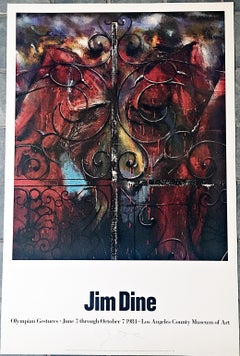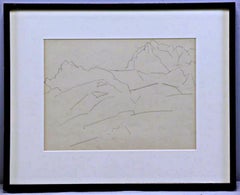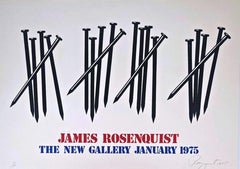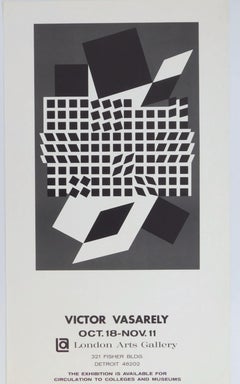Charmion von Wiegand
Pillar of Zen #124, 1959
Gouache on paper painting
Hand signed, titled and dated on the front
Unique
Provenance: Andre Zarre Gallery, with label verso
(Estate of renowned gallerist Andre Zarre, ne Andre Sowulewski)
Measurements:
Framed
26.5 inches vertical by 25.5 horizontal by 2 inches
Artwork:
21 inches vertical by 22 inches horizontal
Mid century modern, geometric, spiritual abstraction, mystical
The Estate of the celebrated artist Charmion Von Wiegand has been represented exclusively by Michael Rosenfeld Gallery since 1998.
From March 3 to August 13, 2023, Charmion Von Wiegand was the subject of an acclaimed retrospective at the Kunstmuseum Basel, and she has received major attention in the price, including a June, 2023 ArtNews feature entitled, "Who Was Charmion von Wiegand and Why Is She Important?". Her work was also featured in a solo presentation by Rosenfeld Gallery at the New York Art Show held at the Park Avenue Armory, which also received critical acclaim.
Artists Biography - courtesy of Michael Rosenfeld Gallery:
Known for her vibrant, geometric paintings that originate a deeply personal language of spiritual enlightenment expressed through a constructivist mode of abstraction, Charmion von Wiegand (1896–1983) was born in Chicago but spent much of her childhood traveling. The daughter of a journalist for Hearst, von Wiegand eventually settled in New York in 1915 to attend Barnard College and Columbia University, where she took classes at the School of Journalism while nurturing a growing interest in art history. In 1925, von Wiegand realized that she wanted to be an artist and set up a studio in Greenwich Village, teaching herself how to paint while pursuing a career as a journalist. In 1929, she secured a position in Moscow as a foreign correspondent for Hearst, the only woman at the desk at the time.
In 1932, von Wiegand returned to New York and married Russian émigré Joseph Freeman, who co-founded and edited the leftist journal New Masses. Von Wiegand began writing art criticism for New Masses as well as for other publications, including New Theatre, ARTnews, and Arts Magazine. When the Abstract American Artists (AAA) held their inaugural exhibition, von Wiegand reviewed it. An early champion of abstract art, von Wiegand became close friends with AAA founder Carl Holty. In 1941, Holty introduced von Wiegand to Piet Mondrian, who would have a profound impact on her art. Fascinated by Mondrian’s artistic philosophy, von Wiegand played a key role in the introduction of his work to American audiences, translating many of the Dutch artist’s writings into English and assisting in the composition of his influential article “Toward the True Vision of Reality” (1941). Through her friendship with Mondrian, von Wiegand re-kindled her interest in Theosophy (a religion established in the late 19th century that combines aspects of Hinduism, Buddhism, occultism, and esotericism) and embarked on an extended study of neoplasticism. In her artwork, she incorporated Mondrian’s iconic grid but rejected the constraints of pure neoplasticism and embraced a wide range of influences including surrealism and German expressionism.
In 1942, von Wiegand became a member of the AAA, exhibiting regularly with the group and eventually serving as its president from 1951 to 1953. In the late 1940s, sculptor and fellow AAA member Ibram Lassaw gave her a translation of The Secret of the Golden Flower: A Chinese Book of Life, which inspired von Wiegand to immerse herself in a study of Buddhist art. She began incorporating Buddhist motifs such as stupas and mandalas into her paintings, and her spiritual practice steadily intensified throughout the 1950s. In 1953, her husband gifted her a copy of the Taoist I Ching Book of Changes, a guide for divining meaning from randomly derived numbers arranged in a hexagram—a form the artist readily incorporated into her painting. Von Wiegand’s study of Theosophy also intensified over these years, bolstered by her increased access to the religion’s primary sources composed by the religion’s founders and their successors at the New York Theosophical Society’s library. Von Wiegand’s search for the sacred and transcendent ultimately led her to Tibetan Buddhism and, in 1967, von Wiegand met Khyongla Rato Rinpoche, a Gelugpa monk who had recently arrived in New York, who would mentor her spiritual study in the tradition of Mahayana Buddhism until her death. Her travels in the 1960s and 1970s took her to Tibet and India, where she had an audience with the Dalai Lama, who was living in exile in Dharamsala. Many works from these decades incorporate symbols and schematics drawn from Theosophical prismatic color charts, Chinese astrology and tantric yoga.
In 1978, she was the subject of a PBS documentary titled The Circle of Charmion von Wiegand, which was scored by Philip Glass. In 1980, von Wiegand was elected to the American Academy of Arts and Letters and in 1982, the Bass Museum of Art in Miami Beach (FL) organized her first retrospective exhibition. She died the following year in New York, bequeathing her estate to Khyongla Rato and the Tibet Center of New York. In 1998, Michael Rosenfeld Gallery became the sole representative of her estate and has presented her work in four solo and multiple group exhibitions. Recent notable exhibitions that have included her work are The Third Mind: American Artists Contemplate Asia (Solomon R. Guggenheim Museum, New York, NY, 2009) and Constructive Spirit: Abstract Art in South and North America (Newark Museum, NJ, 2010). In March 2023, the Kunstmuseum Basel (Switzerland) opened the first comprehensive museum retrospective of von Wiegand’s work in Europe.
Von Wiegand’s work is represented in numerous museum collections including the Addison Gallery of American Art, Phillips Academy (Andover, MA); Albright-Knox Art Gallery (Buffalo, NY); Arithmeum, University of Bonn (Germany); Birmingham Museum of Art (Alabama); Blanton Museum of Art, The University of Texas at Austin; Brooklyn Museum (NY); Carnegie Museum of Art (Pittsburgh, PA); The Cleveland Museum of Art (OH); Indianapolis Museum of Art (IN); Fondazione Marguerite Arp (Locarno, Switzerland); Museum of Fine Arts, Boston (Massachusetts); The Metropolitan Museum of Art (New York, NY); The Museum of Modern Art (New York, NY); Newark Museum of Art (New Jersey); Seattle Art Museum (WA); Smithsonian American Art Museum (Washington, DC); Walker Art Center (Minneapolis, MN); Weatherspoon Art Museum, The University of North Carolina at Greensboro; Wellin Museum of Art at Hamilton College (Clinton, NY); Whitney Museum of American Art (New York, NY); and Yale University Art Gallery (New Haven, CT).
More about gallerist Andre Zarre
A tribute in the New Criterion:
Dispatch
August 11, 2020
Andre Zarre, 1942–2020
by Dana Gordon
On the late New York gallery pioneer.
Art should never be aggressively explained; art should be felt.
—Andre Zarre, 1977
Often, in the starlit New York cultural mecca, a longtime important figure fades away through the penumbra and dies without notice. Such was the fate of Andre Zarre, the contemporary art dealer, who passed away a few weeks ago.
Andy, as he wanted friends to call him, opened his eponymous gallery in 1974 just off Madison Avenue on Sixty-ninth Street. He soon moved it to the omphalos of the art world in that era, 41 East Fifty-seventh Street, the Fuller Building. Over the years he moved to SoHo and then to Chelsea, as fashion and real estate prices pushed the art souk hither and thither.
To understand his importance, all you need do is take a look at a list of artists who had solo shows at the Andre Zarre Gallery. This includes such names, from an early generation, as Sonia Delaunay, Nassos Daphnis, Sari Dienes, and Perle Fine. Among a subsequent generation are Pat Lipsky, Jay Milder, Thornton Willis, and Kes Zapkus.1
And this list does not include the many knowns and unknowns who were in his lively group shows. Zarre had a real “eye” and was a champion of abstract art from the moment he founded his gallery—even among the gathering storms of conceptual and political art, which he eschewed. He showed a good deal of figurative art as well. His galleries were always spacious and unpretentious, oriented simply to show the art. In the words of Dee Shapiro, who showed with the Zarre gallery many times, “He had a photographic memory and knew a lot about art and was always interested in the artist’s life.”
Reliable biographical information on Zarre is scarce, but he said of his background that he was born in Poland in 1942 and that his parents were a diplomat and a socialite. He left home for the United States at the age of fifteen. During his decades as an art dealer in New York, Zarre did not appear to accumulate wealth, though he acquired a collection and lived on Park Avenue. “He was not personally aggressive in that way. People had to come to him,” Dee Shapiro said. He was honest in his financial dealings with artists, which not all art dealers are. For a long time while running the gallery he had a second job as a supervisor in an airline office and he kept little to no additional staff in the gallery. He supported a brother who remained in Poland.
Among artists, Zarre was known to be quite ornery. After my show at his gallery in 1997, I refused to enter it for seventeen years. Then I ran into him in Chelsea and he offered me another show, an opportunity I gladly accepted, but he remained just as disagreeable. He showed the work of many women, probably more than any other gallery, save those devoted to showing only women. Collectors, curators, and writers found him mostly friendly. As Peter Reginato put it, Zarre was a “strange guy but I liked him. I think he was a dealer who was more interested in the art than in making money, but somehow he lasted forty-plus years.”
Zarre is not known to have kept extensive or extant records of his gallery’s long history, though these may emerge in time. Scouring the Internet, one may compile a partial list of more than eighty artists who had solo shows at the Andre Zarre Gallery:Nancy Azara, Ellen Banks, Mary Barnes, Tony Bechara, Juan Bernal, Stephanie Bernheim, Randy Bloom, Elena Borstein, Michael Boyd, Fritz Bultman, Ed Buonagurio, Yoan Capote, Sonia Delaunay, Nassos Daphnis, Cathy Diamond, Sari Dienes, Joseph Dolinsky, Beata Drozd, Ronnie Elliot, William Fares, Perle Fine, Lynne Frehm, Ben Georgia, Mikel Glass, Dana Gordon, Juanita Guccione, Fred Gutzeit, Don Hazlitt, Amy Hill, Clinton Hill, Monroe Hodder, Budd Hopkins, Arlan Huang, Richard Hunt, Rhia Hurt, Buffie Johnson, Alexander Kaletski,
Robert Kaupelis...





